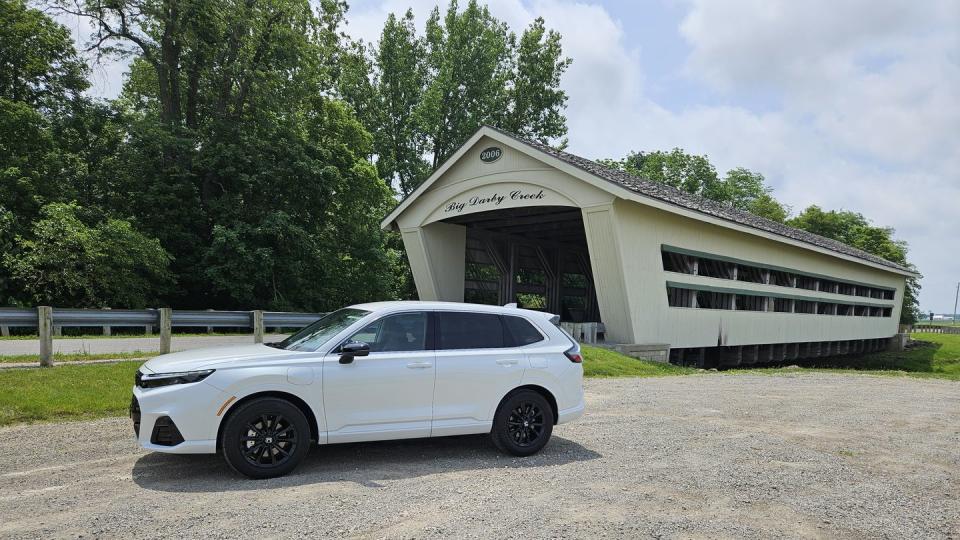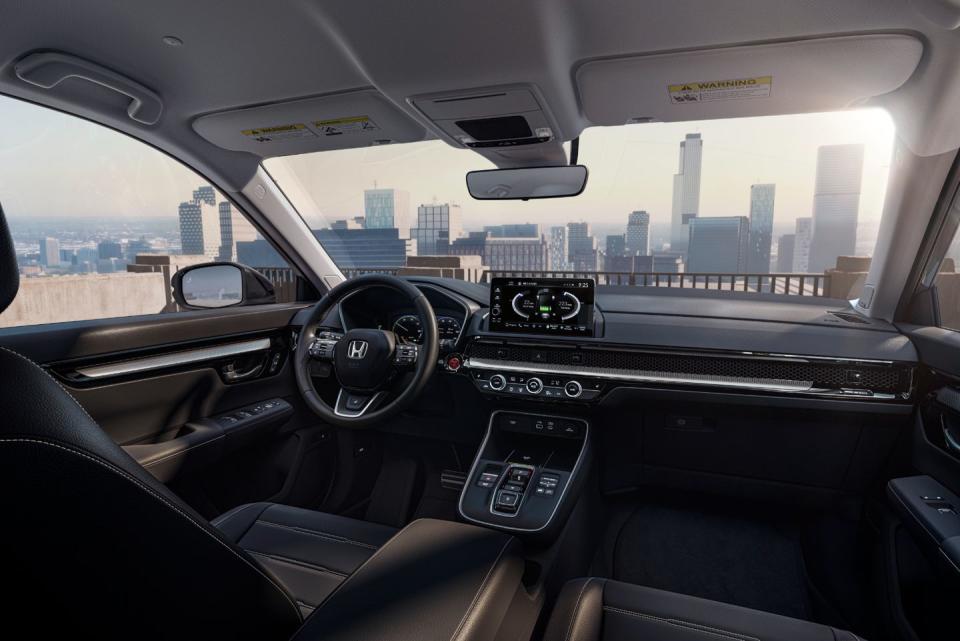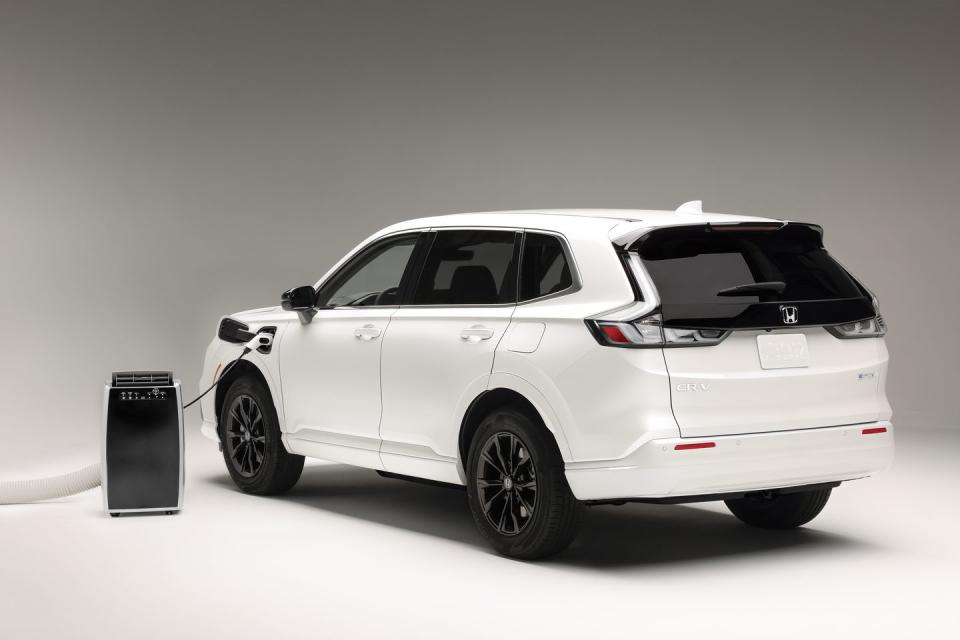2025 Honda CR-V e:FCEV Is Here, but the Cards Are Stacked Against It

There’s nothing objectionable about driving this comfortable, hydrogen-powered crossover. The interior is standard-issue CR-V, except the shift lever in the center console is replaced with push-button controls in the FCEV.
Honda is counting on most customers in California to choose a three-year/36,000-mile lease for $459 a month, and that includes $15,000 of hydrogen refueling credits. A two-year lease will cost $489 a month, with a $25,000 hydrogen fuel credit. Or consider the six-year lease.
Problem is, the most abundant element on Earth is also the least available to consumers wanting to use it as fuel in their cars.
Automakers such as Honda, General Motors, Hyundai, Toyota, and BMW are truly playing the long game when considering which propulsion technologies are best suited for coming generations of passenger cars.
After all, it takes deep, deep pockets to invest in emission-free fuel cells, place them on board vehicles, and install high-pressure tanks to store the compressed hydrogen necessary to create electricity to turn the wheels.
Those investments have piled up over the years as these automakers have pushed ahead with their latest prototypes and a handful of extremely low-volume production vehicles, the latest of which comes from Honda in the form of the very familiar CR-V e:FCEV.
We drove this five-passenger crossover recently in Marysville, Ohio, where Honda’s Performance Manufacturing Center just started building what probably will be fewer than 500 vehicles in the first full year. For context, Honda built and sold 360,000 conventionally powered CR-Vs in the US in 2023.
There’s nothing objectionable about driving this comfortable, hydrogen-powered crossover. The interior is standard-issue CR-V (a good way to save money), except the shift lever in the center console is replaced with push-button controls in the FCEV.
And the gauge cluster and central touchscreen have been adapted with relevant powertrain info.

If you like the silent wisp from behind the wheel of battery-electric vehicles, you’ll find this experience in the FCEV to be very similar, with ample low-end torque that peaks at 229 lb-ft. There’s little sacrifice in performance.
It’s a bit louder than a battery-electric as the fuel cell under the hood hums while it converts compressed hydrogen to electricity for powering the 174-hp electric motor, but not as loud as an internal-combustion engine or fuel-cell vehicles of the past.
Some of the energy produced is used to directly drive the motor and the wheels, and some of it is stored in the battery for later use.
And here’s something unique in the realm of fuel-cell vehicles: This CR-V is a plug-in hybrid with a total range of 270 miles, including 29 miles of battery-electric range. So if you can’t find a hydrogen station, you can at least plug in for a nominal amount of electricity to get around.
That 29 miles of battery-electric range is stored in a much smaller 17.7-kWh battery—about a quarter of the battery size in a modern EV. That’s a benefit because the world’s lithium supplies will be sorely taxed if battery-electric forecasts hold up.
More plentiful than lithium is hydrogen. But, ironically, the most abundant element on Earth is also the least available to consumers wanting to use it as fuel in their cars.

California is the place you gotta be to find hydrogen pumps, but there are only 55 stations (mostly around Los Angeles and San Francisco), while two are under construction and 18 are in the permitting process, according to the Hydrogen Fuel Cell Partnership.
Further hindering the market is Shell USA’s decision earlier this year to close six of its seven hydrogen fueling stations. Would Shell close a fueling station if it was making money? No. So this means CR-V fuel-cell intenders will have fewer places to stop for hydrogen.
Did we mention it will only be available in the state of California, starting July 9? This week Honda shares the three leasing options, all requiring down payments of about $3,000. The car cannot be purchased now or when the lease ends.
Honda is counting on most customers to choose a three-year/36,000-mile lease for $459 a month, and that includes $15,000 of hydrogen refueling credits. A two-year lease will cost $489 a month, with a $25,000 hydrogen fuel credit. If you’re thinking longer term, a six-year lease is available for $389 a month, and the fuel credit is $30,000.
At these prices, Honda isn’t making money, but that doesn’t seem to be the point: Building and selling only 500 of these a year merely softens the economic blow. The Toyota Mirai is the only fuel-cell car to achieve decent volume—about 25,000 on the road in California since arriving in 2014. But profitable? Doubtful.
The main reason automakers throw money in the fuel-cell furnace is because a day may come when petroleum is no longer available, or when governments outright ban internal-combustion vehicles.

Despite their shortcomings, fuel cells remain one of numerous—to borrow a term used by auto executives—arrows in the quiver of automotive propulsion.
For Honda and other forward-thinking automakers, fuel cells are a way to stay in the good graces of the California Air Resources Board, which has been strong-arming automakers for decades in an effort to curb smog and other air pollution.
The goal makes sense, but the business case for fuel cells does not.
If hydrogen was more readily available and a fuel-cell car was priced in line with an EV, which would you choose? Please comment below.

 Yahoo Autos
Yahoo Autos 